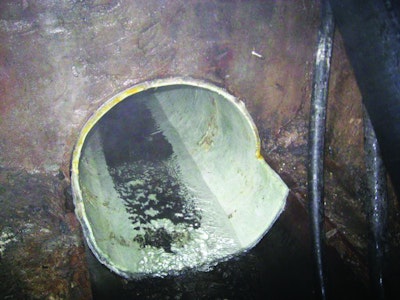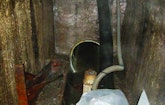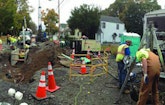
Interested in Relining/Rehab?
Get Relining/Rehab articles, news and videos right in your inbox! Sign up now.
Relining/Rehab + Get AlertsSince 2011, spring rains in Kingston, New York, activated a sinkhole in Washington Avenue, 92 feet above the Tannery Brook Tunnel floor. High levels of fine, silty sediment rushing into the tunnel’s 24-inch vitreous clay sanitary sewer caused operational difficulties at the wastewater treatment plant.
Ongoing repairs by the Department of Public Works failed to stem the problems. In July 2014, part of the avenue caved in, leaving a 75-by-30-by-10-foot-deep hole. Although the affected 190 feet of sewer had broken or missing sections, enough pipe remained to restore it.
Precision Industrial Maintenance of Schenectady, New York, won the bid. “The deep tunnel was a constant 53 degrees and wet from numerous 60 gpm leaks,” says Mike App, project manager. “In those conditions, the best CIPP product with the fastest cure rate is the UV-cured SAERTEX fiberglass-reinforced plastic liner.”
Once on site, everything they thought they knew about the job changed on the fly, as massive forces broke equipment and pushed the six workers to their limit.
What goes in must come out
The city closed off the two-block area, giving App’s team unlimited access. He worked with Bill Verhayden, PIM’s environmental health and safety manager, to plan daily procedures, while the crew organized homeowners’ departures and arrivals.
Entry to the tunnel was a 36-inch-diameter shaft 90 feet deep. Upstream, the combined sewer separated 190 feet behind a 14-inch-thick concrete headwall 4 feet high. The 24-inch stormwater line passed above the wall, while only the top half of the sanitary sewer ran through the bottom of the wall. The other half was in the tunnel floor.
“Stormwater discharged to a creek 4,000 feet from our work area,” says App. “We had phenomenal airflow.”
Planning the order in which equipment went down and how to get it down was critical, for there was no room in the tunnel to jockey it about. The shaft also had to remain open enough to safely lower and retrieve workers past the hoses and metal stubs that once supported ladder rungs. Thick foil covered the stubs to protect men and equipment. In an emergency, the nearest confined space exits were 1,100 feet away at Elizabeth Street through a 24-inch manhole, or 3,000 feet in the opposite direction to a 36-inch sewer with a 30-inch manhole.
App hired Kilby & Gannon Construction of Albany, New York, to set up a 4-inch bypass system capable of handling 900,000 gpd. Once they established it, App’s crew inserted a RapidView IBAK North America camera and cleaned the pipe with two quick passes from the jetter on a Vactor 2100 combination truck.
Week one
App special ordered 1,500 feet of 3/8-inch swage cable rated for 10 tons, but Jason Homrighaus fabricated most other components on site. “Engineering-wise, everything about this project was massive, as were the forces on the rollers and braces,” says App. “Jason used 1/2-inch Schedule A square steel stock, and it still bent or broke.”
The 12 mil liner, weighing 4,500 pounds, would make two 90-degree turns and travel 1,100 feet during installation. “Friction was our biggest obstacle,” says App. “Overcoming it required custom-made rollers with snatch blocks and screw jacks.”
Homrighaus and Rob Chrysler used battery-operated hammer drills to install rollers at the bottom of the Tannery Brook shaft and the Elizabeth manhole. The extra-large adjustable roller for the top of the headwall centered the swage cable as it pulled in the liner, then workers would reposition it, enabling the UV cable to move through it during the cure.
Setup required 12-hour days with experienced confined-space personnel laboring in total darkness except for the 5 feet illuminated by their headlamps. Even simple tasks took an exceptional amount of time, and they lost all concept of it. No matter what clothing they wore, they were always soaked and cold.
“Two of my best guys became badly disoriented and we had to get them out,” says App. “By Friday, exhaustion was becoming a safety issue, so I sent everyone home early for the weekend.”
Worst week
On Monday, the long-range forecast predicted rain toward the end of the week. “If it began raining during the cure, things could turn nasty,” says App. “Nevertheless, we couldn’t move fast without putting someone in an unsafe situation.”
The crew parked the 10-ton winch from a bucket machine over the Elizabeth manhole, then ran out all of the cable. Workers fed it down the shaft and around the designed roller at the bottom, then 1,000 feet through the storm sewer to the roller at the bottom of the Tannery Brook shaft and up to the surface.
Meanwhile, others prepared the liner in its UV-proof, waterproof sleeve. They positioned the leading edges of the liner inward, secured them with ratchet straps to form a nose, and attached the cable when it arrived.
“Whenever a cable turns, it loses strength,” says App. “The moment a roller bent and the cable hit something, the immense forces broke it.” It happened three times. Each six- to eight-hour repair in a 3-foot-wide by 5.5-foot-high area required Homrighaus to stand hunched over and in knee-deep water as he spliced the broken wires with cable connections.
Heave ho!
To help relieve friction on the liner, the crew hoisted it down the shaft in 5-foot increments with a chain. After the winch took up the slack, they repeated the process.
The bypass system discharged into a 36-by-24-by-14-inch-deep hole leading to the sanitary sewer. Standing in the hole, Tim Nappi disconnected the cable when the liner arrived. A worker on the other side of the wall retrieved the cable, tied it to a rope, attached the other end to the camera and sent it up the sewer to Nappi. With the cable attached, he helped push the liner down the hole with each pull of the winch.
Inserting the liner took 12 1/2 hours. Then workers cut it to length, inserted steel packers (cans) on either end and secured them with ratchet straps to seal the liner. Using a 375 cfm air compressor, they inflated the liner at 20 psi, inserted the tag line and pulled back the Double Core 9-foot-long light train with eight 1,000-watt UV bulbs.
“Fore and aft cameras on the train enable us to inspect the liner as we pull the train to its head,” App says. “When we finally turned on the lights, we had worked 48 hours straight.”
Soggy homestretch
A computer controlled the speed of the light train – 6 to 9 inches per minute based on the liner’s diameter and thickness. “The rain and the cure began at 1 a.m.,” says App. “When we finished seven and a half hours later, more than an inch of rain had fallen. Debris clogged the bypass pumps and they couldn’t keep up. With the liner plugging the outflow, 300,000 gallons of wastewater piled up behind the headwall.”
Unable to retrieve their equipment and open the sewer, they went home and waited five days for flows to subside. “We left everything hooked up and hoped it would survive,” App says. “It did.”
Since PIM completed the two-and-a-half-week project, no sediment has reached the treatment plant.









